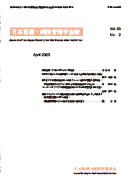Volume 60, Issue 2
Displaying 1-6 of 6 articles from this issue
- |<
- <
- 1
- >
- >|
Perspective
-
2023Volume 60Issue 2 Pages 43
Published: April 30, 2023
Released on J-STAGE: April 28, 2023
Download PDF (146K)
Original article
-
2023Volume 60Issue 2 Pages 44-52
Published: April 30, 2023
Released on J-STAGE: April 28, 2023
Download PDF (525K)
Research notes
-
2023Volume 60Issue 2 Pages 53-61
Published: April 30, 2023
Released on J-STAGE: April 28, 2023
Download PDF (579K) -
2023Volume 60Issue 2 Pages 62-72
Published: April 30, 2023
Released on J-STAGE: April 28, 2023
Download PDF (540K)
Report
-
2023Volume 60Issue 2 Pages 73-82
Published: April 30, 2023
Released on J-STAGE: April 28, 2023
Download PDF (867K)
Editorial
-
2023Volume 60Issue 2 Pages 83
Published: April 30, 2023
Released on J-STAGE: April 28, 2023
Download PDF (169K)
- |<
- <
- 1
- >
- >|
